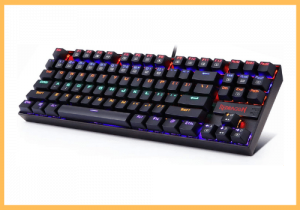Rubber dome keyboards lie under a type of keyboards that do not use mechanical switches for the keys, nor do they use capacitive or membrane switches.
Instead, the rubber dome uses a mechanism in which springs are attached to each key.
It works like this;
The spring is pushed down when a key is pressed, and the rubber dome collapses under pressure. Rubber domes have a set travel point, after which they are fully depressed, and are one of the least expensive ways to make a keyboard.
However, they are less durable and responsive than a mechanical keyboard. If a rubber dome key is pressed, it requires a great deal of force to press, and it will quickly break if used often. On the other hand, you can fix a broken mechanical switch.
Click To See Content Of This Post
- 1 Types Of Rubber dome Keyboards:
- 1.1 How Do Rubber Dome Keyboards Work?
- 1.2 Rubber Dome Keyboard Material and Overall Structure:
- 1.3 Rubber Dome Keyboard Keycaps:
- 1.4 Rubberized Keys:
- 1.5 Inexpensive to Produce:
- 1.6 Mechanical Vs. Membrane Keyboard For Gaming:
- 1.7 Programmable Keys:
- 1.8 Quieter:
- 1.9 You Have To Compromise on Durability:
- 1.10 Some Downsides:
- 1.11 How Long Do Membrane Keyboards Last?
Types Of Rubber dome Keyboards:
There are two types of rubber domes: single-piece and multi-piece.
Single-piece rubber domes have one layer of plastic in the center of each key; multi-piece rubber domes have several layers of plastic in the center of each key.
Multi-piece rubber domes are more durable than single-piece ones, but they’re also more expensive and harder to manufacture.
How Do Rubber Dome Keyboards Work?
Rubber dome keyboards are among the most affordable, cheapest, and most abundant types of keyboards in the world. The main idea behind this tech is that the keys are made out of silicone membranes, and each key has a set of contacts under each key.
Down the road, a rubber dome keyboard has a flat piece of rubber that lies underneath each keycap. When you press down on a key, the rubber dome flattens out under your finger to create an electrical connection that tells your computer what letter or symbol you pressed.
After you release the key, the spring pushes it back up into its original position so that you can use it again later.
When they were first invented in the 1980s, rubber dome keyboards were much more expensive than traditional mechanical ones because they required more complex manufacturing processes.
As technology improved and costs went down, rubber dome keyboards became much more popular for business use because they could be mass-produced cheaply and sold for less than mechanical models.
Rubber Dome Keyboard Material and Overall Structure:
Rubber dome keyboards use a rubber material under the keys to provide feedback. The rubber is flexible enough that it can be pushed down by the user, but it will not return to its original position on its own.
Instead, each key has a small plastic dome attached to it that pushes down on the rubber dome when pressed. It enables the keyboard to register a keypress and sends information to your computer.
Rubber Dome Keyboard Keycaps:
Rubber dome keycaps are one of a kind. That said, instead of having individual switches underneath each keycap.
Similarly, the keycaps themselves are made from plastic or metal and press down onto this switch when pressure is applied. The pressure triggers the switch, which sends an electrical signal to your computer telling it which key you pressed.
Rubberized Keys:
The keys of these computer keyboards are made from soft, flexible plastic. The keys are molded into the domes, so they form the top, bottom, and sides of the keycaps. It allows you to feel the position of your fingers on the domes without having to look down at all.
Inexpensive to Produce:
Many people like the soft-touch feel of these keys. Also, the biggest advantage of these is that they cost less to manufacture than their mechanical counterparts, and it means people on a lower budget can opt for them.
Mechanical Vs. Membrane Keyboard For Gaming:
Many gamers prefer mechanical keyboards because they offer better response times and tactile feedback when pressing keys. Down the road, these keyboards tend to be more expensive than their rubber dome counterparts (and many gamers don’t want to spend extra money just for gaming).
However, the problem with the rubber dome keyboard switches starts when you press down on a key because there is no tactile feedback from the switch mechanism, which can lead you to lose digital wars.
Another thing, when you’re typing at high speeds, you can’t tell when one keystroke ends and another begins — but more importantly, for gaming, you don’t know when you’ve pressed down enough to register a keypress.
It means that if your keys are soft or sticky, there’s no way for you to tell whether or not they’re registering until after you’ve pressed them down all the way. And then it might be too late!
Programmable Keys:
One feature of a rubber dome keyboard is that you can program keys on it using software provided by the manufacturer or other third parties.
It’s pretty useful for things such as macros or accessing system settings without having to go through complex key combinations or memorizing long strings of keystrokes.
Moreover, enabling and customizing Programmable Key functionality is simple and intuitive. Simply press Fn + the desired function key to access its programming menu.
After that, use the arrow keys to select any of the available functions. Once you’ve made your selection, press Enter to lock in your choice and return to normal operation.
Quieter:
Membrane keyboards are generally quieter than standard mechanical ones because they do not rely on a switching mechanism. As you know now, each key pushes itself to the rubber structure, which eliminates incoming noise locally.
Due to this, a lot of people, mostly office workers and front-end web developers, love to have a membrane layout keyboard on their desks.
You Have To Compromise on Durability:
Durability is something the former wins in with ease when it comes to mechanical keyboards vs. membrane keyboards.
Mechanical keyboards are built specifically to last for a longer period of time. Whereas, if something happens to a key on a membrane keyboard, you’d need to replace the entire board – which isn’t an affordable option as they aren’t exactly cheap.
As opposed to this, mechanical keyboards are more affordable and provide you with various choices for keys and switches.
Some Downsides:
The biggest problem with rubber membrane keyboard switches is that they’re not very durable. If you press too hard or accidentally hit two keys at once, then you’ll break the circuit board beneath your keys.
That’s why so many people find themselves replacing their keyboard every few years or so — if you take care of your keyboard properly, it will last longer than this!
Moreover, the second problem with rubber domes is that they don’t feel like mechanical switches. They’re not as tactile, and they don’t have nearly as much travel distance between when you press a key and when it registers as depressed — about 1-2 mm compared to 4-5 mm for mechanical switches.
Also Read:
- What is a Bluetooth Keyboard
- How Long do Membrane Keyboards Last
- Can You Use A Keyboard On A Laptop?
How Long Do Membrane Keyboards Last?
Well, the average key life on rubber dome switches is from 3 to 5 million key presses.
That’s it:
So, now you know what are rubber dome keyboards after reading this in-depth and highly researched guide. Lastly, the rubber dome keyboard switches are good enough for normal typists, but if you’re a keyboard warrior, it’s better to opt for mechanical switches.





![Dell kb216 Keyboard Driver Error [SOLVED!]](https://kmgadvice.com/wp-content/uploads/2023/04/luca-bravo-XJXWbfSo2f0-unsplash-360x240.jpg)